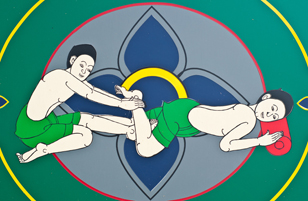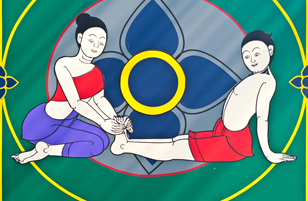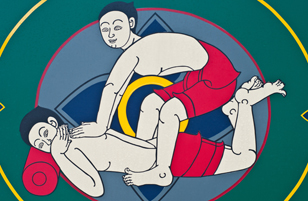What is Thai Massage?
From Wikipedia:
“Thai massage is a system of massage and assisted stretching developed in Thailand, and influenced by the traditional medicine systems of India, China, and Southeast Asia.
This form of bodywork is often performed on the floor, and the client wears comfortable clothes that allow for movement. No oils are used in Thai massage.”
Ancient Thai Massage was based on a medicine system closely related to (and probably derived from) Ayurvedic medicine from India. Of course there were and still are many regional styles of Thai Massage, and each one of those styles takes from the Traditional form, and adds to it local folk remedies and techniques. Traditional Chinese Medicine (Five Element Theory and the 14 basic meridians) is often used in Thai Massage but that system is used in addition to, not in place of, The Traditional Thai system of the Ten Sen lines.
In Thai Massage, stretching arose partly as a system of working the energy, or “Lom” that exists in the joints. Today, stretching is the hallmark of Thai Massage. One variant of Thai Massage, called Thai Yoga, is the application of the Thai stretching, while eliminating the use of pressure.
The pressure used in a Thai Massage can be quite strong! While it can be considered “energy work” there is nothing “esoteric” about the pressure used. We live in a Western culture however, and it is common and acceptable to accomodate the preferences of The Client. Generally, what I aim for, in terms of pressure, could be described as “Bearable Discomfort”.
What is Tuina?
Tuina (pronounced “tway nah”) is the form of medical massage used in China. It is perhaps best to say that Tuina is a set of techniques – over 1,000 hand techniques – used in conjunction with Five Element Theory, Yin-Yang Theory, or Traditional Chinese Medicine. In the West, Tuina is often called “Accupressure”.
The Tuina Practitioner uses hand techniques to a) manipulate soft tissue (muscle) and b) manipulate the Qi of the body to begin / promote healing of the body and achieve correction of the dysfunction.
It might seem trivial to say, but there is no School of Massage Therapy that does not have it’s roots in Tuina – from Swedish Massage to Thai Massage to Shiatsu. Tuina is the foundation of modern massage. And yet most significantly, Tuina is still being taught, used, and developed in China and is regarded there as a medical therapy.
Traditional Chinese Medicine has a 5,000 year history. It is an integrated healthcare system incorporating Internal Medicine (herbs), Accupuncture, Tuina (massage), Zheng Gu (what we might call Chiropractic), and Qigong (energy work).
Zheng Gu Shui is commonly used for Tui Na. Zheng Gu Shui’s liquid formula was created by a Chinese master herbalist over 500 years ago and used to heal fractures and broken bones through Tui Na.
What is Five Element Theory?
Five Element Theory and Yin Yang Theory, the core of Traditional Chinese Medicine.
The Five Elements: Earth, Fire, Water, Metal, and Wood, govern and control organ systems, senses, and tissues in the body. Each organ system, each tissue, has it’s own Qi. Some Qi is Yang, some Qi is Yen, and for each element, there is one Yang organ system, and one Yin organ system. The Yin organ system depends up on the Yang organ system, and vise versa. Likewise, as these systems depend upon one another, they also govern and nourish one another. Returning the body to health then, is a matter of maintaining a balance of Qi. When there is an excess of Kidney Qi, this will affect the Urinary Bladder. The imbalance may manifest itself as pain in the Lumbar. Kidney is the Yin Water element, and may be controlled by the Yin Earth element, Spleen.
In Traditional Chinese Medicine, these two theories: Five Element, and Yin Yang Theory, are responsible for everything in our human experience. They are the physical, the psychological, and the spiritual elements of life.


